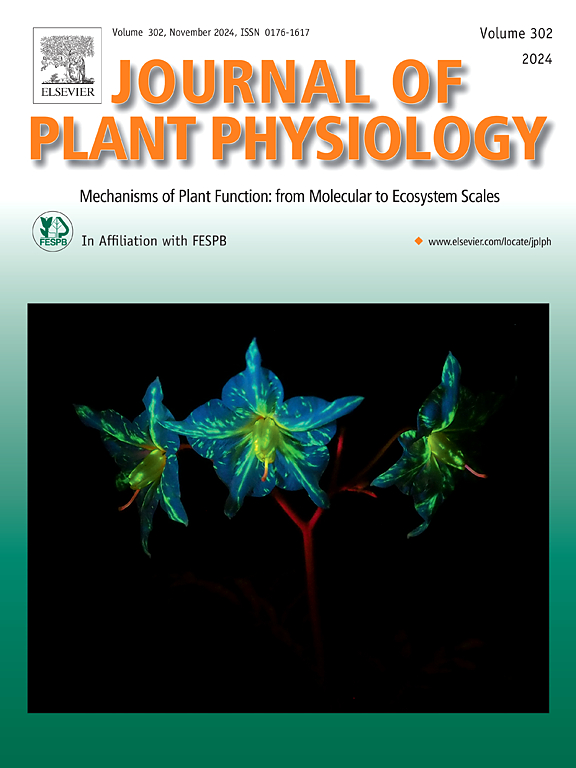用基因编码的生物传感器照亮植物代谢
IF 4.1
3区 生物学
Q1 PLANT SCIENCES
引用次数: 0
摘要
植物的代谢灵活性使它们能够很好地应对不断变化的环境条件。这种灵活性是通过细胞过程实现的,细胞过程需要在空间和时间上紧密协调,并不断平衡以最大限度地提高植物的适应性。如果我们想要鉴定出产量更高、抗非生物和生物胁迫能力更强的作物,那么我们需要通过实验来解开这些代谢过程,而基因编码生物传感器(geb)似乎是理想的选择。它们允许对活细胞的代谢过程进行无创监测,并具有高空间和时间分辨率。已经在植物中开发或建立的传感器和传感器变体的列表不断增长,为了解越来越多的植物代谢参数提供了见解。这与技术进步一起,也促进了交叉和多路复用实验,其中多个进程同时由geb监测。尽管有这些优点,geb需要谨慎使用,用户必须充分了解它们在所选实验植物系统中的特性,以便从传感器的光谱变化中得出有意义的结论。在这里,我们的目标是提供一个可以选择用于植物的荧光geb列表,并强调从它们获得的最新生物学见解,重点是多种geb已经使用的进展。我们还讨论了选择合适传感器的标准以及该领域仍然具有挑战性的方面,希望帮助植物科学家以有意义的方式使用geb生成和解释植物代谢数据。本文章由计算机程序翻译,如有差异,请以英文原文为准。

Illuminating plant metabolism with genetically encoded biosensors
The metabolic flexibility of plants enables them to cope particularly well with changing environmental conditions. This flexibility is achieved by cellular processes that require tight coordination in space and time and constant balancing to maximise plant fitness. If we want to identify crops with higher yields and improved resistance to abiotic and biotic stresses, then we need to unravel these metabolic processes experimentally, and genetically encoded biosensors (GEBs) seem ideal for this. They allow non-invasive monitoring of metabolic processes in living cells over time and with high spatial and temporal resolution. The list of sensors and sensor variants that have been developed or established in plants continues to grow, providing insights into more and more parameters of plant metabolism. This, together with technological advances, also facilitates paraplexing and multiplexing experiments, where several processes are monitored simultaneously by GEBs. Despite these advantages, GEBs need to be used carefully and users must fully understand their characteristics in the chosen experimental plant system in order to draw meaningful conclusions from the spectroscopic changes of a sensor. Here, we aim to provide a list of fluorescent GEBs that can be selected for in planta use and highlight recent biological insights gained from them, focusing on advances where multiple GEBs have been used. We also discuss criteria for selecting an appropriate sensor and aspects of the field that remain challenging, in the hope of helping plant scientists to generate and interpret plant metabolism data using GEBs in a meaningful way.
求助全文
通过发布文献求助,成功后即可免费获取论文全文。
去求助
来源期刊

Journal of plant physiology
生物-植物科学
CiteScore
7.20
自引率
4.70%
发文量
196
审稿时长
32 days
期刊介绍:
The Journal of Plant Physiology is a broad-spectrum journal that welcomes high-quality submissions in all major areas of plant physiology, including plant biochemistry, functional biotechnology, computational and synthetic plant biology, growth and development, photosynthesis and respiration, transport and translocation, plant-microbe interactions, biotic and abiotic stress. Studies are welcome at all levels of integration ranging from molecules and cells to organisms and their environments and are expected to use state-of-the-art methodologies. Pure gene expression studies are not within the focus of our journal. To be considered for publication, papers must significantly contribute to the mechanistic understanding of physiological processes, and not be merely descriptive, or confirmatory of previous results. We encourage the submission of papers that explore the physiology of non-model as well as accepted model species and those that bridge basic and applied research. For instance, studies on agricultural plants that show new physiological mechanisms to improve agricultural efficiency are welcome. Studies performed under uncontrolled situations (e.g. field conditions) not providing mechanistic insight will not be considered for publication.
The Journal of Plant Physiology publishes several types of articles: Original Research Articles, Reviews, Perspectives Articles, and Short Communications. Reviews and Perspectives will be solicited by the Editors; unsolicited reviews are also welcome but only from authors with a strong track record in the field of the review. Original research papers comprise the majority of published contributions.
 求助内容:
求助内容: 应助结果提醒方式:
应助结果提醒方式:


